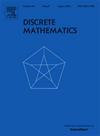关于一些同调d流形的构造
IF 0.7
3区 数学
Q2 MATHEMATICS
引用次数: 0
摘要
简单复形的g向量包含了该复形的组合结构和拓扑结构的大量信息。关于正规伪流形和同调流形在g2值下的结构,建立了几个分类结果。已知当g2=0时,所有至少3维的正规伪流形都是叠球。在g2=1和2的情况下,所有的同调流形都是多面球,可以通过对前两个同调流形的再测量或连接操作得到。在本文中,我们给出了d≥3且g2=3的同调d流形的组合表征。这些都是球体,可以通过连接、一些再变换、g2≤2的球体的连通和等运算得到。进一步,我们给出了g2=3的素数正规d-伪泛褶的一个结构结果。本文章由计算机程序翻译,如有差异,请以英文原文为准。
On a construction of some homology d-manifolds
The g-vector of a simplicial complex contains a lot of information about the combinatorial and topological structure of that complex. Several classification results regarding the structure of normal pseudomanifolds and homology manifolds have been established concerning the value of . It is known that when , all normal pseudomanifolds of dimensions at least three are stacked spheres. In the cases of and 2, all homology manifolds are polytopal spheres and can be obtained through retriangulation or join operations from the previous ones. In this article, we provide a combinatorial characterization of the homology d-manifolds, where and . These are spheres and can be obtained through operations such as joins, some retriangulations, and connected sums from spheres with . Furthermore, we have presented a structural result on prime normal d-pseudomanifolds with .
求助全文
通过发布文献求助,成功后即可免费获取论文全文。
去求助
来源期刊

Discrete Mathematics
数学-数学
CiteScore
1.50
自引率
12.50%
发文量
424
审稿时长
6 months
期刊介绍:
Discrete Mathematics provides a common forum for significant research in many areas of discrete mathematics and combinatorics. Among the fields covered by Discrete Mathematics are graph and hypergraph theory, enumeration, coding theory, block designs, the combinatorics of partially ordered sets, extremal set theory, matroid theory, algebraic combinatorics, discrete geometry, matrices, and discrete probability theory.
Items in the journal include research articles (Contributions or Notes, depending on length) and survey/expository articles (Perspectives). Efforts are made to process the submission of Notes (short articles) quickly. The Perspectives section features expository articles accessible to a broad audience that cast new light or present unifying points of view on well-known or insufficiently-known topics.
 求助内容:
求助内容: 应助结果提醒方式:
应助结果提醒方式:


